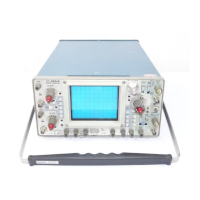Maintenance—465B Service
5.
Place
the cabinet handle against the bottom of the
cabinet (bottom of cabinet is nearest to the carrying
handle pivot points).
6.
Pull the power cable
through the cabinet and
carefully slide
the
cabinet over
the instrument. Avoid
pinching cables
or
damaging components
that protrude
from circuit boards.
7.
Using
both hands,
press
lightly on the top and
bottom
sides of
the cabinet until
the front edge of the
cabinet is inserted
into
the braided gasket groove around
the full periphery of the front cabinet frame.
8.
Pull the power cord through the rear cabinet
frame,
align the cutout portion in the frame for proper fit at the
regulating
range
selector
cover, and work the frame into
place.
9.
Set the feet and screws in place and with one hand
exert alight downward pressure on the
rear
cabinet frame.
Press lightly on the top and bottom sides of cabinet with
the other
hand, checking
that cabinet edge is
properly
seated in
the gasket groove of both front and rear frames.
Continue to exert a downward pressure and tighten the six
screws of the rear frame to a snug fit. Do not over-tighten
these screws.
Rack Adapter Removal
The Rack Adapter can
be
removed
from the instrument
in
the following manner:
1. Removethe hardware that fastens the
Rack Adapter
to the rack and pull
the adapter partially out. Disconnect
the instrument power cord
from the power source and
remove
any
interconnecting
cables.
NOTE
It if is desired to tilt the Rack Adapter and
instrument,
remove a screw from the rear of each slide section
mounted
to
the Rack
Adapter. These securing
screws are an important part of the mounting and
should be installed when tilt operation
is not
necessary.
2.
Remove
the
Rack
Adapter, with instrument, from
the
rack and set the bottom of the complete assembly on
a flat
surface.
3. Remove two setscrews
from the top front of Rack
Adapter
chassis, (0.125-inch Allen wrench
is required to
remove the
setscrews). It may
be
helpful
to use the
diagrams in Section
9,
Replaceable
Mechanical Parts
List,
for the locations
of parts.
4. Remove
10 screwsthatsecuretherearsupport
plate
to an
angle
bracket on one
side, to the Rack Adapter
chassis on the
opposite side, and to the
rear of the
instrument. Removethe
rear support plate and blue plastic
rear frame.
5. Slide
the
instrument
forward through
the adapter
cabinet, using
both hands
(on
front and
rear) to lift and
guide the instrument
until separated from
the Rack
Adapter.
WARNING
Dangerous potentials exist
at several points
throughout
this instrument. When
the instrument is
operated with
the Rack Adapter removed,
do not
touch
exposed connections or components.
Some
transistors
may have elevated cases.
Disconnect
power before
cleaning the instrument or replacing
parts.
Rack Adapter Installation
The Rack Adapter should
be installed in the following
manner:
1.
Disconnect
the instrument power cord from
the
power source.
2.
Verify proper assembly of all sections
of the instru-
ment
if
parts
were
removed
or replaced. It
may be helpful
to use the diagrams in Section
9,
Replaceable
Mechanical
Parts
List, for the locations of parts.
3.
Set
the bottom of the Rack Adapter on
a
flat surface,
pull
the power cord through the cabinet portion
of the
Rack Adapter, and carefully slide the
instrument rearward
using both hands (on front and rear)
to lift and
guide
the
instrument
until fully inserted. Avoid pinching cables
or
damaging components
that protrude from circuit boards.
4.
Check that the front edge
of
the cabinet portion
of
the Rack Adapter is inserted into
the braided gasket
groove around the full periphery
of
the
instrument front
frame. Pull
the power cord through
the
blue
plastic rear
frame. Align
the cutout portion in the plastic frame for
proper fit at the regulating-range
selector cover and work
the frame
into place.
@
5-2

